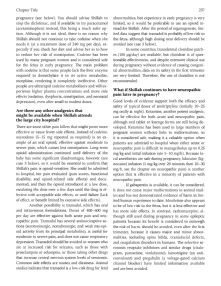Page 249 Guide to Pain Management in Low-Resource Settings
P. 249
Chapter Title 237
pregnancy (see below). You should advise Shillah to abnormalities, but experience in early pregnancy is very
stop the diclofenac, and if available to try paracetamol limited, so it would be preferable to use an opioid in-
(acetaminophen) instead, this being a much safer op- stead for Shillah. After the period of organogenesis, lim-
tion. Although it is not ideal, there is no reason why ited data suggest that tramadol is probably of low risk to
Shillah should not continue to take codeine when she the fetus, although high dosing near delivery should be
needs it (at a maximum dose of 240 mg per day), es- avoided (see case 3 below).
pecially if you check her diet and advise her as to how In some countries, transdermal clonidine patch-
to reduce her risk of constipation. Codeine has been es (100 μg/day) are available, but clonidine is of ques-
used by many pregnant women and is considered safe tionable eff ectiveness, and despite extensive clinical use
for the fetus in early pregnancy. Th e main problem during pregnancy without evidence of causing congeni-
with codeine is that some people lack the liver enzyme tal abnormalities, data on its safety in the fi rst trimester
required to demethylate it to its active metabolite, are very limited. Th erefore, the use of clonidine is not
morphine, rendering it completely ineff ective. Other recommended.
people are ultrarapid codeine metabolizers and will ex-
perience higher plasma concentrations and more side What if Shillah continues to have neuropathic
pain later in pregnancy?
eff ects (sedation, dysphoria, constipation, and neonatal
depression), even after small to modest doses. Good levels of evidence support both the effi cacy and
safety of typical doses of amitriptyline (initially 10–25
Are there any other analgesics that mg orally at night). Ketamine, another potent analgesic,
might be available when Shillah attends can be eff ective for both acute and neuropathic pain,
the large city hospital?
although oral tablet or lozenge forms are still being de-
Th ere are some other pain killers that might prove more veloped. Ketamine has been used in large numbers of
eff ective or cause fewer side eff ects. Instead of codeine, pregnant women without links to malformations, so
oxycodone (5–15 mg repeated as required) is an ex- it is considered safe, making it a valuable option when
ample of an oral opioid, eff ective against moderate to patients are admitted to hospital when either acute or
severe pain, which causes less constipation. Long-term neuropathic pain is diffi cult to manage(bolus up to 0.25
opioid administration continued until delivery of the mg/kg and initial infusion rate 5–10 mg/h). Because lo-
baby has some signifi cant disadvantages, however (see cal anesthetics are safe during pregnancy, lidocaine (lig-
case 3 below), so it would be essential to confi rm that nocaine) infusion (1 mg/kg over 20 minutes then 10–30
Shillah’s pain is opioid-sensitive. She could be admitted mg/h, see the chapter on neuropathic pain) is another
to hospital, her pain evaluated (pain scores, functional option that is eff ective in a minority of patients with
disability, and opioid-related side eff ects) and docu- neuropathic pain.
mented, and then the opioid introduced at a low dose, If gabapentin is available, it can be considered.
escalating the dose over a few days until the drug is ef- It does not cause major malformations in animal stud-
fective with acceptable side eff ects, or until failure (lack ies and has not demonstrated evidence of harm in lim-
of eff ect, or benefi t limited by excessive side eff ects). ited human experience to date. Mexiletine also appears
Another possibility is tramadol, which has oral to be of low risk to the fetus, but it is less eff ective and
and intravenous formulations. Doses of 400–600 mg has more side eff ects. In contrast, carbamazepine, al-
per day are eff ective against both acute pain and neu- though still used during pregnancy in some epileptic
ropathic pain. Tramadol has several antinociceptive ac- patients because its benefi t is considered to outweigh
tions (serotoninergic, noradrenergic, and weak mu-opi- the risk of harm, should be avoided, even after the fi rst
oid activity from its principal metabolite), is useful for trimester, because it causes major and minor abnor-
moderate to severe pain, and does not cause respiratory malities, including spina bifi da, craniofacial defects,
depression. Tramadol should be avoided in women who and coagulation disorders in humans. Th e selective se-
are at increased risk for seizures, such as those with rotonin reuptake inhibitors and similar drugs (citalo-
preeclampsia or eclampsia, or those taking other drugs pram, paroxetine, venlafaxine), lamotrigine (an anti-
that increase central nervous system levels of serotonin. convulsant) and pregabalin (a voltage-gated calcium
Common side eff ects are nausea and dizziness. Animal channel blocker) have limited information available
studies indicate that tramadol is a low-risk drug for fetal and are best avoided.


